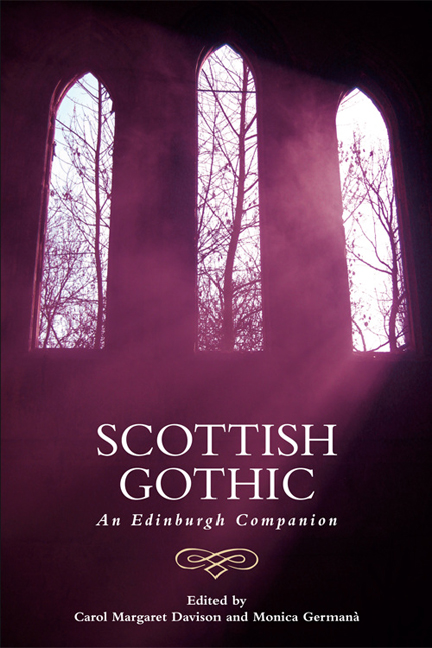Book contents
- Frontmatter
- Contents
- Acknowledgements
- 1 Borderlands of Identity and the Aesthetics of Disjuncture: An Introduction to Scottish Gothic
- 2 ‘The Celtic Century’ and the Genesis of Scottish Gothic
- 3 The Politics and Poetics of the ‘Scottish Gothic’ from Ossian to Otranto and Beyond
- 4 Robert Burns and the Scottish Bawdy Politic
- 5 Scottish Gothic Drama
- 6 Scottish Gothic Poetry
- 7 Calvinist and Covenanter Gothic
- 8 Gothic Scott
- 9 Gothic Hogg
- 10 ‘The Singular Wrought Out into the Strange and Mystical’: Blackwood's Edinburgh Magazine and the Transformation of Terror
- 11 Gothic Stevenson
- 12 J. M. Barrie's Gothic: Ghosts, Fairy Tales and Lost Children
- 13 The ‘nouveau frisson’: Muriel Spark's Gothic Fiction
- 14 Scottish Gothic and the Moving Image: A Tale of Two Traditions
- 15 New Frankensteins; or, the Body Politic
- 16 Queer Scottish Gothic
- 17 Authorship, ‘Ghost-filled’ Islands and the Haunting Feminine: Contemporary Scottish Female Gothic
- Notes on Contributors
- Index
7 - Calvinist and Covenanter Gothic
Published online by Cambridge University Press: 20 December 2017
- Frontmatter
- Contents
- Acknowledgements
- 1 Borderlands of Identity and the Aesthetics of Disjuncture: An Introduction to Scottish Gothic
- 2 ‘The Celtic Century’ and the Genesis of Scottish Gothic
- 3 The Politics and Poetics of the ‘Scottish Gothic’ from Ossian to Otranto and Beyond
- 4 Robert Burns and the Scottish Bawdy Politic
- 5 Scottish Gothic Drama
- 6 Scottish Gothic Poetry
- 7 Calvinist and Covenanter Gothic
- 8 Gothic Scott
- 9 Gothic Hogg
- 10 ‘The Singular Wrought Out into the Strange and Mystical’: Blackwood's Edinburgh Magazine and the Transformation of Terror
- 11 Gothic Stevenson
- 12 J. M. Barrie's Gothic: Ghosts, Fairy Tales and Lost Children
- 13 The ‘nouveau frisson’: Muriel Spark's Gothic Fiction
- 14 Scottish Gothic and the Moving Image: A Tale of Two Traditions
- 15 New Frankensteins; or, the Body Politic
- 16 Queer Scottish Gothic
- 17 Authorship, ‘Ghost-filled’ Islands and the Haunting Feminine: Contemporary Scottish Female Gothic
- Notes on Contributors
- Index
Summary
We don't need mair doubles, oor haill fuckin culture's littered wi them. If it's no guid versus evil it's kirk elders versus longhairs, heid versus hert, Hieland and Lowland, Glasgow and Edinburgh, drunk men and auld wifies, Protestants and Catholics … Holy Willies and holy terrors, you name it Scotland's fuckin had it.
(Robertson 2001: 25)So the protagonist of James Robertson's novel of nation-building and history, The Fanatic, declaims to his mirror in 1997, the year of the vote for devolution. Nationalism, then as now, provides a fantasy of a hope of unitary identity for Scotland, which will put to rest the warring dualities of its past. The irony of Robertson's Daniel Carlin raging against duality lies in the words immediately following this extract: ‘I am talkin tae you, by the way’, to which his mirror responds, ‘I ken’ (2001: 25). Carlin may dream of an escape from the complexities of history, but the past forms a hole in the back of his mind through which the ‘Killing Times’ of the Covenanter Wars of the late seventeenth century invade the present-day Edinburgh world of ghost tours, tourists and dossers.
In examining the long engagement of Scottish fiction with the Covenanters and Calvinist duality from Walter Scott to James Robertson, this chapter argues that there is indeed no escape from such narrative patterns, but that, rather than a nightmare from which an enlightened nation seeks to awake, the double has the potential to provide a productive episteme through which to think, allowing its multiple identities to be acknowledged. Moreover, the Covenanter conflict becomes, as it were, a macrocosmic version of the individual's struggle, and even here, the most effective fictional treatments are those that acknowledge and dramatise the multiplicity of perspectives and loyalties at play in society and in the self.
The Reformation is the founding myth upon which the fear so central to Gothic writing is engendered, in which a Protestant nation escapes from the priestly thrall of the Roman Catholic past, which is represented both by what John Galt terms ‘fat friars’ or the ‘prelatic dragon’ (1899, vol. 1: 34) – tyrannical clerics who cause the death and imprisonment of the just – and by their monastic powerhouses, such as St Andrews, where the salacious Archbishop feasts with his concubine in Galt's Ringan Gilhaize of 1823.
- Type
- Chapter
- Information
- Scottish GothicAn Edinburgh Companion, pp. 89 - 101Publisher: Edinburgh University PressPrint publication year: 2017

